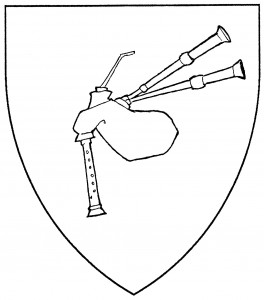A bagpipe is a double-reed musical instrument with a windbag that also supplies sonant force to a set of drone reeds. It’s sometimes more fully blazoned “a set of bagpipes”; though known across Europe, bagpipes are most strongly associated with Scotland. Bagpipes are found in period armory, in the canting arms (Italian cornamusa) of Cornamusini, c.1550 [BSB Cod.Icon 278:287], and as the badge of Aubrey of Breconshire, 1531 [Siddons II.2 18]. One amusing example, the arms of Fitz-Ercald, c.1520, shows three hares playing bagpipes [DBA1 294].
As to the bagpipe’s depiction, the Luttrell Psalter, c.1340, has an example of a single-droned bagpipe; no period bagpipe has been found with more than two drones. The third drone wasn’t added to the Highland bagpipes until the 18th Century [Grove 2:472]; three-droned pipes are therefore disallowed in Society armory. The bagpipe’s chanter is to dexter by Society default.
Richardus Pfeiffer von Karlstadt bears as a badge: Vert, a set of bagpipes argent.
Conchúr McClawrane Vc Leoid bears: Argent, an arrow bendwise gules, overall a bagpipe azure.
Malcolm of Fife bears: Azure, in pale two bagpipes argent within a bordure Or semy of acorns proper.
